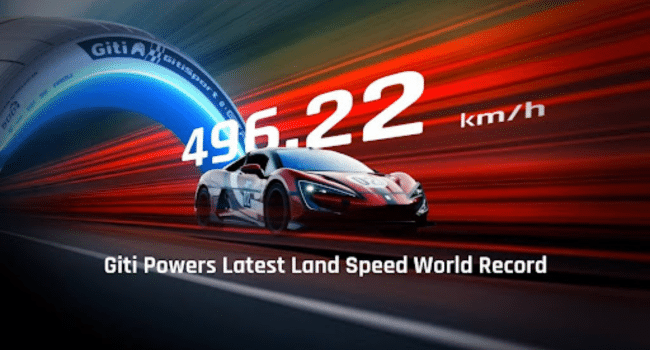Table of Contents
On 14 September 2025, the Yangwang U9X, equipped with GitiSport e.GTR2 Pro tires, became the fastest car on the planet—hitting a top speed of 496.22 km/h. This record wasn’t just about raw power—it showcased how decades of tire innovation and Giti tire milestones enabled performance that now filters into consumer tire tech.
A Leap in Speed: From 472 to 496
Just weeks earlier, on 8 August 2025, the Yangwang U9 (non-X version) had broken the EV land-speed barrier with a run at 472.41 km/h using the same e.GTR2 Pro model. Less than six weeks later, the team returned to the same proving grounds in Germany to push the envelope again. This time, the upgraded U9X car + refined setup hit 496.22 km/h—a 23.81 km/h gain.
What’s remarkable isn’t just the top speed, but the consistency and engineering precision: the tires had to endure intense aerodynamic loads, heat stress, and full-throttle torque. Giti’s engineers monitored every variable to ensure that the tires performed as designed under extreme forces.
The Engineering Inside e.GTR2 Pro
This tire is not a simple aftermarket race piece—it’s a culmination of advanced engineering tailored for hyper-performance. Here are the key features:
- Molecular Chain Optimization: The internal rubber structure is reinforced to resist tearing and deformation under high tension, ensuring stability at ultra speeds.
- Ultra-High-Strength Aramid Fibres: Giving structural stiffness without excessive weight, these fibres help the tire maintain form when pushed to limits.
- Next-Gen Racing Profile Geometry: The shape is optimized to maintain uniform contact patch under extreme loads, reducing hotspots and uneven wear.
- RaceGrip Pro Compounds: Giti has engineered filler materials that increase grip (≈ 38%) while widening the effective temperature window—so the tire adheres better across cold start to heated conditions.
- Anti-Standing Wave Structure: At nearly 500 km/h, tires can form wave-like oscillations that lead to failure. This structure suppresses such dangers, maintaining tire integrity.
- Fast Warm-Up Additives: Time matters. These additives help the tire reach optimal working temperature ~60 % faster. For the record run—and for everyday driving—faster warm-up means safer grip earlier.
- Bionic Sidewall Design: Inspired by biological structures, the sidewall strikes a balance between flexibility and support. It helps in cornering stability without making the ride overly harsh.
Further, the tire carries CCC/ECE certification, enabling road-legal performance despite its extreme capabilities.
Giti’s Historical Context: How Milestones Built the Foundation
This record didn’t emerge in a vacuum. It’s rooted in Giti’s long trajectory of growth, innovation, and motorsport engagement. Some notable milestones:
- 1951: Giti began as a manufacturer of bicycle tires and inner tubes in Indonesia.
- 1971: Signed a technical assistance agreement with a Japanese company to produce motorcycle tires.
- 1981: Expanded into bias tires for passenger and commercial vehicles.
- 1993: The “Giti Tire” brand was established with a passenger/light truck tire factory in Anhui, China.
- 1994: Earned European quality certifications (E-Mark).
- 1995: Established Giti Tire Fujian; earned ISO 9002 & TÜV certifications.
- 2005: Expanded to the U.S. market with a new branch.
- 2013: Supported the “Girls Only” racing team—an all-female team that won class titles in VLN racing on Giti tires.
- 2017: Made its Nürburgring racing debut in the 24 Hours Nürburgring, finishing strong in class.
Each of these steps built technical capability, global reach, and credibility. The lessons from motorsport, quality standards, and R&D investment all contributed to the capability to create a tire like e.GTR2 Pro.
Why This Record Matters to You
You might wonder: how does a 496 km/h run affect my daily drive? The connection is direct:
- Safety Buffer: A tire engineered to withstand extreme forces has a built-in margin for emergency handling, braking, and dynamic stress.
- Technology Diffusion: Many features—compound blends, sidewall reinforcement, thermal control—trickle down into performance and premium road tires.
- EV Compatibility: As EVs grow more powerful and heavier, tires must keep up. This record shows that Giti’s tech is already future-ready for high torque, heavy loads, and heat management.
- Brand Assurance: Customers can trust that their tire brand has proven its mettle at peak extremes—not just in marketing.
FAQs
Q1: How does this record differ from the earlier run?
Answer: The U9X’s setup (aero, power delivery, car dynamics) and refined tire tuning allowed a further 23.81 km/h increase. The record shows evolution, not luck.
Q2: Is e.GTR2 Pro sold to regular drivers?
Answer: The exact spec used for the record may be bespoke, but many of its core technologies are incorporated into high-performance street-legal tires in Giti’s consumer line.
Q3: Are these record-setting tires safe for road use?
Answer: Yes—they carry CCC/ECE certifications. Giti ensures they meet legal and safety standards even while extending performance.
Q4: What makes tires critical in EV performance?
Answer: EVs deliver instant torque and carry heavier batteries. Tires must resist deformation, manage heat, and maintain grip—roles that e.GTR2 Pro was designed for.
Q5: How does this boost Giti’s reputation in the tire industry?
Answer: It reinforces Giti as a tech-forward brand capable of outperforming in extreme conditions—putting it alongside established premium names on the performance stage.
Key Takeaways
- The Yangwang U9X achieved a world record of 496.22 km/h with GitiSport e.GTR2 Pro tires.
- This was a second groundbreaking record in one year (after 472.41 km/h).
- Advanced technologies like RaceGrip Pro, molecular chain optimization, and anti-standing wave structures made it possible.
- Giti’s historical milestones—from its founding to global expansion and motorsport engagements—laid the foundation.
- Everyday drivers benefit via the transfer of technology: safer, more durable, and performance-ready tires.
Conclusion
The 496.22 km/h run by Yangwang U9X (on Giti tires) isn’t just a triumph of speed—it’s proof of human engineering, innovation, and persistence. It shows that the tire is not simply an accessory—it’s a critical enabler.
Next time you choose a tire, remember: the breakthroughs that push hypercars to world records are also what protect you and your vehicle on everyday roads. Look for tires built on technology, heritage, and proven performance.
